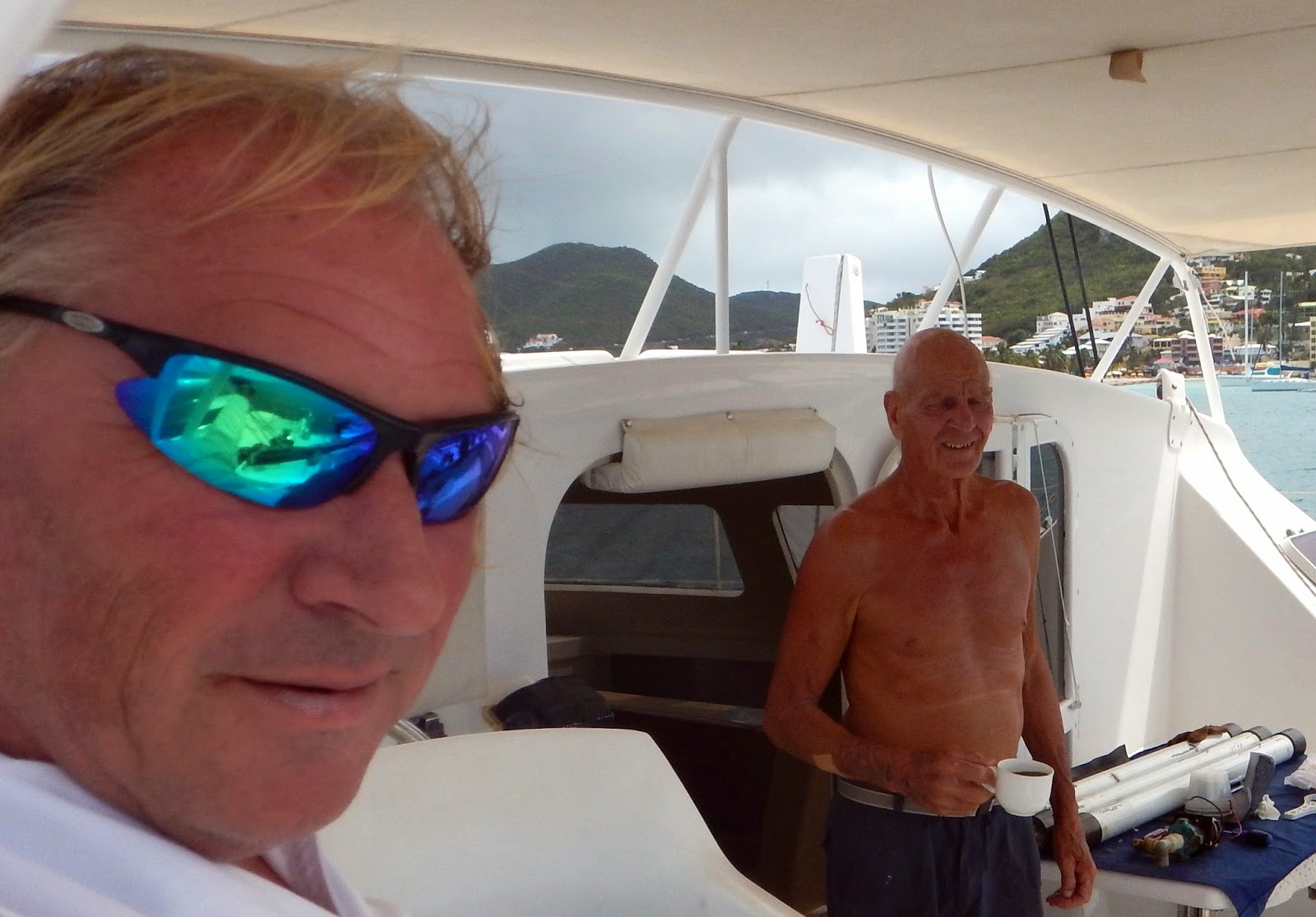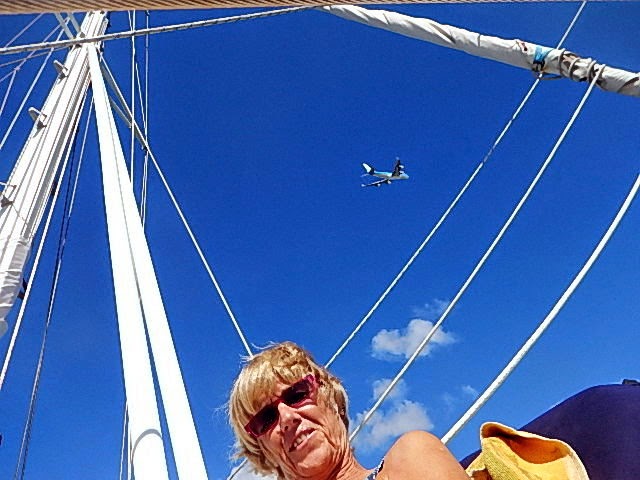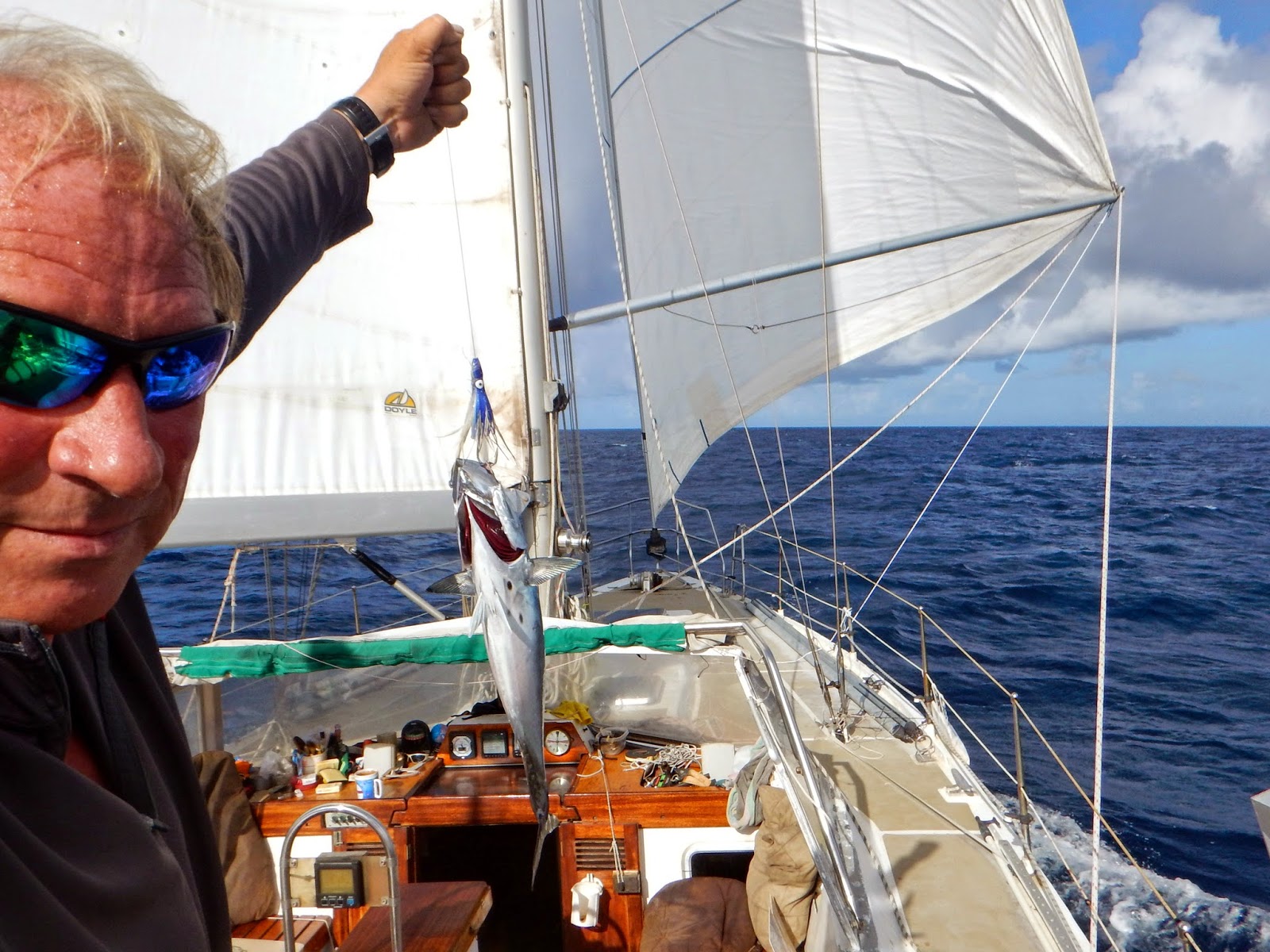Clearing out from Antigua.. Next in line with the Rambler. They take inside corner, ok, so go in front, but now Customs gave them my papers and customs found out when they had already left with my papers, leaving me with the Ramblers papers.. Customs guy went after them (gone for half hour)... etcetc... At the end of the morning we were cleared out..
Back to St Maarten... (repairs etc)
Customs Nelsons Dockyard Antigua...
Saturday, February 28, 2015
Sunday, February 22, 2015
Out the bridge
To Antigua later 2 day..Nice wind.. (UTC.. -4)
Anchor back in just in time..
For sale Joop
Sliverland and Stad Amsterdam in distance.. Simpson Bay
This is the wind the 600 will have.. Start before 1200 23rd.. Ist finisher 26th..?
Anchor back in just in time..
For sale Joop
Sliverland and Stad Amsterdam in distance.. Simpson Bay
This is the wind the 600 will have.. Start before 1200 23rd.. Ist finisher 26th..?
Wednesday, February 18, 2015
Pics of the (Wens)day
Ach.. pics of the day..
Beating Albert (and 4 others before I lost), pool SoggyDollar (with Olly van der Voort) and Mike and Edgar van Burkom,
Silverland Marije Den Breems Simpson Bay and Escapade Dawn Pooley and Jonathan going to Pinel (my advice)..
and Aragon getting ready for the 600 (per adres Roel ten Hoopen),
OssenPfeffer back on lagoon Robbie Ferron)
and David and Ginger..
I win 5 games in a row (1 from Albert) and lose last one in absolute winning position but black clips out of intended corner to end in wrong opposite corner.. arg
Palapa/SoggyDollar bar.. btw the big mast on the left.. is the Wally (with very expensive and not nice 'dog house' ) Better Place. http://www.boatinternational.com/yacht-features/better-place-wallys-latest-flagship/
Nb Olly inside playing with new Tablet, moving to other cabin, changing the linen etc.. — with Edgar Albert and Mike
Nice shiny boat gives nice reflection of me..
Silverland and Escapade.. And late Steve Jobs Venus etc.. Simpson bay — with Marije Den Breems, Marco and Jonathan and Dawn Pooley.
Coffee with Joop
Aragon .. need try sail for 600..
Van van Dam.. for sale like many.. http://www.superyachts.com/motor-yacht-4428/icon.htm
OssenPfeffer
David and Ginger
Beating Albert (and 4 others before I lost), pool SoggyDollar (with Olly van der Voort) and Mike and Edgar van Burkom,
Silverland Marije Den Breems Simpson Bay and Escapade Dawn Pooley and Jonathan going to Pinel (my advice)..
and Aragon getting ready for the 600 (per adres Roel ten Hoopen),
OssenPfeffer back on lagoon Robbie Ferron)
and David and Ginger..
I win 5 games in a row (1 from Albert) and lose last one in absolute winning position but black clips out of intended corner to end in wrong opposite corner.. arg
Palapa/SoggyDollar bar.. btw the big mast on the left.. is the Wally (with very expensive and not nice 'dog house' ) Better Place. http://www.boatinternational.com/yacht-features/better-place-wallys-latest-flagship/
Nb Olly inside playing with new Tablet, moving to other cabin, changing the linen etc.. — with Edgar Albert and Mike
Nice shiny boat gives nice reflection of me..
Silverland and Escapade.. And late Steve Jobs Venus etc.. Simpson bay — with Marije Den Breems, Marco and Jonathan and Dawn Pooley.
Coffee with Joop
Aragon .. need try sail for 600..
Van van Dam.. for sale like many.. http://www.superyachts.com/motor-yacht-4428/icon.htm
OssenPfeffer
David and Ginger
Tuesday, February 17, 2015
Ohh .. Gruyere
Enjoying my birthday present from the Highland Breeze.. Good honk of
real Gruyere (sailed in from Curacao last night..).. here melted over a
baguette .. very good, Thanks Albert, Olly Mike and Edgar
Good looking neighbors Dawn and Jonathan..
Jonathan being serviced..
Lia and KLM passing
And here KLM just flew by (now) again an route to Curacao (1400)
Good looking neighbors Dawn and Jonathan..
Jonathan being serviced..
Lia and KLM passing
And here KLM just flew by (now) again an route to Curacao (1400)
Thursday, February 12, 2015
Swim with whales
http://consciousbreathadventures.com/swim-with-humpback-whales/
In the above map, the area marked in dark blue shows the territorial waters of the Dominican Republic; the green shows the waters of the Sanctuary for the Marine Mammals; and in light blue, the “Banco de la Plata” is the Silver Bank.
rules are there, not sure what we will run in to...
The Sanctuary for the Marine Mammals of the Dominican Republic
On October 14, 1986, the Dominican Republic recognized the vital importance of the Silver Bank by establishing the Silver Bank Sanctuary. Ten years later the Dominican Republic strengthened that commitment on July 5, 1996, when a presidential decree enlarged the Sanctuary to its current size and renamed it the Sanctuary for the Marine Mammals of the Dominican Republic.
As part of the Sanctuary, all activity on the Silver Bank must adhere to strict guidelines set forth by the office of the Sub-Secretariat of Protected Areas & Biodiversity of the Dominican Republic, and overseen by the on-site Coordinator of the Silver Bank. Among other things, these guidelines limit the number of vessels on the Silver Bank. In fact, during the whale season no vessel may visit the Silver Bank without a permit. As a guest of Conscious Breath Adventures you will be traveling into this humpback whale habitat with an authorized holder of one of only three permits issued. This limits the total number of guests on the Silver Bank to no more than 54 a week, around 500 in an entire season. The low numbers help protect the whales from excessive contact, but an added benefit for the guest is that it also eliminates crowding.
Typically the daily excursions aboard our whale boats range 3-5 miles from the anchorage, often much less. This leaves the vast majority of the Sanctuary completely undisturbed. It also means that on a planet with a human population of 7 billion, visitors to the Silver Bank are part of a very very small percentage of people fortunate
 enough to experience one of the natural wonders of the world.
enough to experience one of the natural wonders of the world.In the Sanctuary there are specific regulations which govern the conduct of the larger vessels with regards to safety protocols, designated anchorage, maximum speed of operation, and more. There are also guidelines for whale boat approach and surface whale watching which define harassment, and dictate the speed and direction of approach and travel in proximity to the whales and other operators. The rules also set forth the accepted technique for in-water encounters with the whales, referred to as a Soft-In-Water Encounter. The guidelines also ensure that all the operators in the Sanctuary operate in a consistent manner, with an emphasis on communication and cooperation. This ensures that everyone on the Silver Bank safeguards the integrity of the Sanctuary and the humpback whales, and that all actions are governed not just by the letter of the law, but by the spirit of the Sanctuary itself.
Protection and Conservation
By establishing the Sanctuary for the Marine Mammals, the Dominican Republic has continued a decades long progression of environmental conservation and protection. With regards to marine mammals, the Dominican Republic has taken a leading role among Caribbean Basin nations. At a time when some Caribbean nations are quietly supporting the resumption of commercial whaling while publicly advertising themselves as whale watching destinations, the Dominican Republic proudly confirms its commitment to these gentle giants by maintaining this Sanctuary..http://www.colonialtours.com.do/englishballenas.htm....
Sanctuary of Humpback Whales in Samana, Dominican Republic
One of the most beautiful tour in Dominican Republic is the Visit to the Sanctuary of Humpback Whales in Samana, Dominican Republic. Samana's whales are well known. Each year 3 to 5 thousand humpback whales return to Bahia de Samana and adjacent waters to give birth and mate for the following year. From January until March, frolicsome males can be observed vying for the attentions of demure females. Sky-rocketing, standing on their tails (and heads, too!), flippering, tailing; all sorts of antics may be observed under carefully controlled conditions aboard excursion boats staffed by knowledgeable personnel.
Excursions leave from Samana Harbor and several other points along the north shore of the bay. Samana's whales are truly an international treasure and are fully protected by the Dominican government.
Thousands of humpback whales migrate to Samana Bay every year for the breeding season, which runs from January through March. Their journey is a long and slow trek spanning from the polar regions of the North Atlantic to the warm and clear waters of the Caribbean. Regrettably, over the centuries, whale hunters have decimated the population of these magnificent creatures to the point of near extinction. But, thanks to the efforts of organizations such as the International Whaling Commission (IWC), humpback whales along with other species, have received world protection since 1966. However, there is still a long way to go for full recovery. The world population of humpbacks has reached approximately 40,000 or about 30-35% of its original levels.
Humpbacks can be easily observed, either at their
feeding or breeding grounds. Whale watching has become
an increasingly popular worldwide activity, and the
Dominican Republic is fortunate to have one of the
largest and best humpback breeding sanctuaries in the
world.
The
Dominican government enforces strict whale protection
laws and guidelines to ensure the safety and
conservation of these wonderful animals. Whale watching
can be a thrilling experience for anyone interested in
nature and the preservation of our natural resources.
We must
continue to respect and protect these incredibly gentle
giants so we can enjoy them for a long time to come. The
following photos are images of what one would see on a
typical whale-watching tour in Samana Bay, Dominican
Republic.
Colonial Tour and Travel offer you
this beautiful excursion leaving from your hotel by comfortable and secures boats from
the typical port of Samana, including lunches and beverages and assisted by an official
guide in English language.http://en.wikipedia.org/wiki/Whale_watching
......... Caribbean
About 25 species are observed in the Caribbean waters such as Humpback whales, Sperm whales, beaked whales and many other small cetaceans. Principle whale watch activities : Dominican Republic, East Caribbean islands. Caribwhale, the Caribbean whale watch association, include operatprs engaged in a sustainable whale watching activity, experts, conservationists and research groups as the International Fund for Animal Welfare, Dalhousie University and Association Evasion Tropicale.
http://www.noonsite.com/Countries/DominicanRepublic/?rc=Formalities
alternatives.. http://captmikes.com/whale-dolphin-watching/
This should be a must on everyone’s adventure plan and what better place than the blue waters of the Caribbean Sea. Here there are many resident pods as well as migratory ones, so you stand a pretty good chance of a sighting on nearly every trip. There are 33 species of whales and dolphins and over 20 live in and visit our waters. The species that are most commonly sighted are pilot whales, sperm whales, humpbacks and false Orcas. The orca, or killer whales as they are more commonly called are also seen here from time to time, the last encounter being September 2012, we presumed they were on their way south for the winter months. The humpbacks and sperm whales are often spotted with calves, who spend their time playing and frolicking in our coastal waters. The adults love the warm sunny seas and they just relax, swim, play, court and mate, like any regular tourist!
Often we see pods of dolphins swimming with the whales in complete harmony. There are spinners, spotted, bottlenose and Fraser dolphins seen here. They are the oceans performers, leaping as high as 12ft into the air and spinning their their way down into the depths of the ocean, only to surface again, playing in the wake of the boat and bow riding (see photo above). The usual size of a dolphin pod is between 30 – 60 , but recently we have often spotted them in their hundreds.
Another resident of our tropical waters that you might spot is the turtle, as he rises to the surface for air and a general look around. The regulars around here are hawksbill and greenback. CAPTAIN MIKE’S practices safe whale watching by following all the rules and regulations to ensure the absolute safety of the animals. We must also remember that these are wild animals and we are the guests in their territory.
SCHEDULE WHALE WATCHING AND DOLPHIN WATCHING TRIPS
3 hour expedition ————- U.S.$50.00. per person.
Private charters for whale and dolphin watching can be arranged through our office. You can then go for as long as you like and maybe mix it in with a beach picnic or other activity. Whale watching is a year-round activity in St Lucia.
http://www.footprinttravelguides.com/latin-america/caribbean-islands/essentials/sport-and-activities/whale-and-dolphin-watching/
etc
Wednesday, February 4, 2015
Subscribe to:
Comments (Atom)
















































